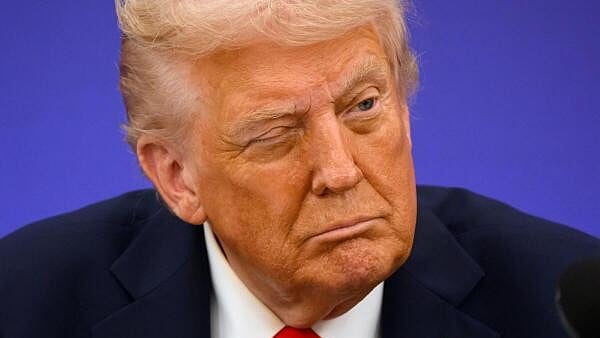
U.S. President Donald Trump.
Credit: Reuters
The Indian response to Washington’s punitive tariff against buying Russian oil and New Delhi’s consequential renewal of camaraderie with Beijing happened just when the European Union was adopting evasive tactics against Donald Trump’s bullying. Images of Prime Minister Narendra Modi, Russian President Vladimir Putin, and Chinese President Xi Jinping at the recent Shanghai Cooperation Organisation (SCO) summit in Tianjin were splashed across European media that closely watched the coming together of Eurasian nations seeking a multipolar world order.
The SCO that followed weeks after the BRICS summit in Rio de Janeiro was widely seen as a tipping point against the US-led unipolar world and the emergence of a powerful Global South. The widespread coverage in the European media about the dramatic pause to the hug-and-tell relationship between Donald Trump and Modi reflected the importance the region accorded to India. European news channels discussed the possible fallout and emphasised the pertinence of embracing the Global South.
German newspaper Frankfurter Allgemeine Zeitung reported on Modi dodging Trump’s phone calls without citing its source. The report picked up by global media further cemented the belief that India had drifted away from the US, although the two countries have since been negotiating a settlement.
In her State of the Union address, European Commission President Ursula von der Leyen emphasised the importance of engaging the Global South and finalising the “negotiations on a historic deal with India by the end of this year.” The EU is currently India’s second-largest trading partner, valued at €120 billion in 2024, 11.5% of India’s exports. But India is only the 9th largest trading partner of the EU. At just 2.4%, India is way behind the US and China.
Commerce Minister Piyush Goyal’s announcement that India was close to signing the FTA by the year-end brought much cheer in the EU region that just can’t wait to tap the market in the world’s most populous country and one of the key players in the Global South. That the EU is still working on the FTA, defying Trump’s call to slap a 100% tariff on India, is a statement of its intent. India had earlier signed a $100 billion free trade agreement with the European Free Trade Association, which represents European nations such as Switzerland that are not part of the EU.
During her visit to India early in the year, von der Leyen had said the India-EU FTA would be the world’s largest. The EU views Russia suspiciously, in trade and security. The invasion of Ukraine has further accentuated its concerns over Moscow’s designs. But India’s close ties with Russia do not come in the way since the EU sees New Delhi as a reliable partner due to its traditionally independent foreign policy.
New market, untapped potential
The range of unconnected ties India maintains with countries as diverse as Russia, the US, Iran, and Israel makes it even more dependable to Europe. India is a key member of the BRICS, SCO, Quad, and I2U2, which comprises India, Israel, the UAE, and the US. While Europe didn’t pull punches when India refused to condemn the Russian invasion of Ukraine, it has not dented New Delhi’s relationship with the region.
Since 80% of EU trade is with countries other than the US, Europe is eyeing markets such as India with much untapped potential. The FDI from the EU to India crossed the €140 billion mark in 2023, while Indian FDI in the EU was just €10 billion. Over 6,000 European companies are now present in India.
The President of Finland, Alexander Stubb, recently cautioned the West, including the US, that “if we don’t engage in a more cohesive and dignified foreign policy, especially with regard to Global South countries such as India, we will lose.” The EU just can’t afford to lose. It is already strapped with rising unemployment, and an additional financial burden to rebuild its military after Trump’s warning against depending on US military bases.
Slowing population growth and a fast-ageing population leave the EU with no option but to attract overseas talent to replace its retiring workforce, ramp up international trade, find new markets for its products, and spend more on research and development.
The EU is aware that India plays hardball, and accessing its market, especially the farm sector, denied even to America, won’t be easy. But with the Trump administration snapping at its heels, the EU seeks the strengthening of partners like India to secure its future in light of a new world order visible on the horizon.
(The writer is a senior journalist based in Berlin)
Disclaimer: The views expressed above are the author's own. They do not necessarily reflect the views of DH.